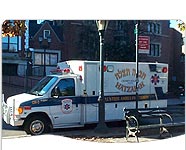 |
 
Prostate Cancer Survival Rates Continue to Climb
By Holly VanScoy , HealthDay Reporter
HealthDay
SUNDAY, Sept. 5 (HealthDay News) -- Scientists are chalking up continued gains in the fight
against prostate cancer.
According to the U.S. National Institutes of Health, advances in diagnosing and treating the
disease are tied to a dramatically improved overall prognosis for prostate cancer patients. Survival
rates for patients at all stages of the disease are now nearing 97 percent.
That's encouraging news worth sharing during September, Prostate Cancer Awareness Month.
The National Cancer Institute (NCI) lists prostate cancer as the second most common cancer in
men, after skin cancer. Some 230,110 American men will be diagnosed with the disease this year,
and about 30,000 will die from it, most from diagnoses in previous years.
But because the disease progresses slowly over the years, experts predict that men are much
more likely to die with prostate cancer than from it. Recent autopsy studies show many men over age
50 have early, undiagnosed prostate cancer, and most early cancers remain harmless, taking years
for them to become life-threatening.
A healthy prostate gland is quite small, about the size and shape of a chestnut. It is located in
front of the rectum, just below the bladder, and wraps around the urethra, the tube that carries urine
from the bladder through the tip of the penis.
One of the newest findings about prostate cancer is that men with low prostate specific antigen
(PSA) levels on screening tests may still have the disease. In an NCI-funded study published in May
2004, researchers detected prostate cancers by biopsy in men with normal PSA levels.
Dr. Ian Thompson, head of the Department of Urology at the University of Texas Health Science
Center at San Antonio, led the NCI-research team. He said the study was the first to systematically
evaluate men with PSA levels from 0 to 4 nanograms per milliliter (ng/ml). A PSA level below 4.0 ng/ml
is considered to be a normal reading. Physicians usually recommend that men with a reading above
4.0 ng/ml have a prostate biopsy to check for cancer or other conditions.
"The main study finding was that 15 percent of the men in the PCPT control group had a positive
end-of study biopsy even though they had PSA levels below 4 ng/ml and normal DREs throughout the
study," said Thompson. "Our research shows that cancer of the prostate can be present in men with
'normal' PSAs."
Since the late 1980s, PSA tests have been widely used in the United States in an attempt to detect
prostate cancer at an early stage. However, PSA testing carries a risk of "over-diagnosing" the disease,
which could lead to unnecessary surgery or radiation therapy. For this reason, PSA screening still isn't a
universally recommended screening procedure.
Dr. Leslie Ford, associate director for clinical research in the NCI's Division of Cancer Prevention,
also participated in the research. "The good news from our study is that the vast majority of the cancers
found in men with PSA levels below 4.0 ng/ml were low- and intermediate-grade malignancies, which
often are not clinically significant."
"We need better methods to distinguish the harmless, slow-growing cancers from the more aggressive
ones," Ford said. "If more biopsies are performed at lower PSA levels, more cancers will be found and
treated. But some men would undergo treatment, and the risks associated with it, for tumors that would
never have been clinically significant."
Treatment for prostate cancer can sometimes lead to impotence, urinary incontinence, and other
problems, causing a substantial health burden for men.
"Lowering the PSA threshold for proceeding to prostate biopsy would increase the risks of overdiagnosing
and overtreating clinically unimportant disease," explained Thompson.
The NCI-funded researchers are now looking for ways to determine which men with low PSA levels
harbor aggressive tumors. Some are using the new tools of genomics and proteomics to look at how gene
expression patterns and proteins in the blood may differ in men with aggressive tumors vs. those with
slow-growing ones.
"There is a great need for methods, beyond tumor grade, to better predict which men have prostate
cancers requiring treatment," said Thompson.
Another important advance in prostate cancer has come from doctors' willingness to use a range of
more powerful interventions more often, including radiation, CT-treatment and androgen deprivation therapy.
According to research published in the July 15, 2004, issue of the International Journal of Radiation
Oncology Biology Physics, radiation oncologists are now using higher doses of external beam radiation therapy
to treat both earlier stages and more aggressive forms of prostate cancer. In 1999, 45 percent of prostate
cancer patients were treated with higher doses of radiation therapy, compared to 3 percent in both 1989 and 1994.
The 1999 Patterns of Care Survey concluded that the results of clinical trials have persuaded many
radiation oncologists to add androgen deprivation therapy to radiation therapy when treating more aggressive
or well-established prostate cancers. The research also showed a significant increase in the use of CT-based
treatment planning and radiation therapy for treatment delivery.
"This is an important study because it looks at changing trends over many years in the use of radiation
therapy for curing prostate cancer in the United States," said Dr. Michael J. Zelefsky, lead author of the study
and a radiation oncologist at Memorial Sloan-Kettering Cancer Center in New York City.
"After careful analysis, we have learned that, in general, more radiation oncologists are applying the
results of clinical trials, which have taught us to use higher dose levels of radiation and integrate hormone
therapy in conjunction with radiation therapy to achieve more successful outcomes for prostate cancer patients.
In short, the trends are demonstrating more precise delivery of high dose treatment," he said.
More information
The National Institutes of Health's Senior Health site has more information about prostate cancer.
Copyright © 2004 ScoutNews, LLC. All rights reserved.
|









